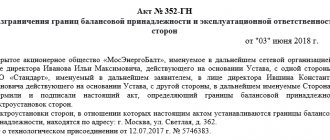| When companies managing multi-apartment residential buildings (MCs) enter into contracts with resource supply organizations (RSOs) for heat, water, electricity and gas supply, disputes very often arise about determining the delivery points of the corresponding resource and the boundaries of the operational responsibilities of the parties under the contract. | Related articles: - Limit of operational responsibility and agreement - Housing inspection inspections: rules of interaction - Concluding an agreement with RSO |
In order to reduce losses on networks, RSO strives to establish the delivery point as far as possible from the end consumer, which is absolutely unprofitable for the other party to the contract. This article will consider a method for legally determining delivery points and the boundaries of operational responsibilities of the parties.
Concepts and regulations.
To begin with, we will determine what is the point of delivery and the boundary of operational responsibility for each type of resource in accordance with current legislation.
The most complete picture of these categories can be formed on the basis of legislative acts regulating the procedure for the supply of electrical energy. Thus, the definition of the delivery point is contained in the Electric Power Industry Rules, approved by Decree of the Government of the Russian Federation dated August 31, 2006 No. 530. This is a place in the electrical network located on the border of the balance sheet ownership of the power receiving devices of the buyer of electrical energy or the person in whose interests he is purchasing it, and is the place fulfillment of the obligation to supply electricity, used to determine the volume of mutual obligations of retail market entities.
As can be seen from this definition, the delivery point is located on the border of the balance sheet, which, in accordance with the Rules of access to services for the transmission of electrical energy, approved by Decree of the Government of the Russian Federation of December 27, 2004 No. 861, is the line of division of electric power facilities between owners on the basis of ownership or possession on another right provided for by federal laws, defining the boundary of operational responsibility between the network organization and the consumer of transmission services (the consumer of electrical energy in whose interests an agreement on the provision of services for the transmission of electrical energy is concluded) for the condition and maintenance of electrical installations.
The boundaries of balance sheet ownership are determined by the act of delimiting the balance sheet ownership of electric networks - a document drawn up in the process of technological connection of energy receiving devices of individuals and legal entities to electric networks.
The limits of responsibility of the parties for the operation of the relevant power receiving devices and power grid facilities are established by the act of delimiting the operational responsibilities of the parties, drawn up by the network organization and the consumer of electric energy transmission services in the process of technological connection of power receiving devices.
The Rules for the Use of Public Water Supply and Sewerage Systems, approved by Decree of the Government of the Russian Federation of February 12, 1999 No. 167, also contain the concepts of boundaries of balance sheet ownership and operational responsibility. In particular, the line of division of elements of water supply and (or) sewerage systems and structures on them between owners on the basis of ownership, economic management or operational management is called the boundary of balance sheet ownership. The boundary of operational responsibility is the line dividing elements of water supply and (or) sewerage systems (water supply and sewerage networks and structures on them) on the basis of duties (responsibility) for the operation of elements of water supply and (or) sewerage systems, established by agreement of the parties. In the absence of such an agreement, the boundary of operational responsibility is determined by the boundary of the balance sheet.
In paragraph 5 of Art. 15 of the Federal Law of July 27, 2010 No. 190-FZ “On Heat Supply” (hereinafter referred to as the Heat Supply Law) also states that the place of fulfillment of the obligations of the heat supply organization is the delivery point, which is located on the border of the balance sheet ownership of the heat consuming installation or the consumer’s heat network and the heat network heat supply or heating network organization or at the point of connection to an ownerless heating network.
Subclause 3 of clause 4 of Art. 17 of the Law on Heat Supply establishes that the responsibility of the heating network and heat supply organizations for the condition and maintenance of heating network facilities is determined by the balance sheet boundary fixed in the act on delimiting the balance sheet ownership of heating networks and the act on delimiting the operational responsibilities of the parties (in the appendices to such an agreement).
According to paragraph 2 of Art. 19 of the Law on Heat Supply, commercial metering of heat energy and coolant is carried out by measuring them with metering devices that are installed at the metering point located on the border of the balance sheet, unless another metering point is specified by the heat supply agreement or the contract for the provision of heat energy transfer services.
The point of metering of thermal energy and coolant is a place in the heat supply system in which, using metering devices or by calculation, the quantity and quality of produced, transmitted or consumed thermal energy and coolant are established for the purposes of commercial metering (Clause 24 of Article 2 of the Heat Supply Law) .
Concepts in the field of gas supply are somewhat different from those given above. They are set out in clause 3 of the Rules for the supply of gas to meet the household needs of citizens, approved by Decree of the Government of the Russian Federation of July 21, 2008 No. 549. Gas supply is considered to be the fulfillment by the gas supplier of obligations arising from the contract, expressed in the performance of a set of actions ensuring the supply of natural gas along the gas distribution network or liquefied hydrocarbon gas from a tank or group cylinder installation to the boundary of ownership of gas distribution (connected) networks, determined in the prescribed manner. In turn, in-house gas equipment includes gas pipelines of an apartment building (ABC) or a residential building connected to a gas distribution network or a tank (group) cylinder installation, providing gas supply to the connection point of gas-using equipment, as well as gas-using equipment and gas metering devices.
Despite the fact that all of the listed legislative acts give different concepts of the point of delivery, the boundaries of balance sheet ownership and operational responsibility, their essence still boils down to the following. The balance sheet boundary, which is the boundary of the division of property, determines the boundary of operational responsibility, as well as the point of delivery of the utility resource (metering point at which the corresponding device is installed). At the same time, the boundary of operational responsibility presupposes a dividing line based on the burden of maintaining the relevant utilities and generally runs along the line of balance sheet ownership, however, the parties to the contract can also agree on a different boundary of operational responsibility.
Composition of the common property of premises owners in apartment buildings.
From the analysis of the above norms it follows that the boundaries of balance sheet ownership depend on the boundaries of ownership, economic management or operational management of utility networks. Therefore, it is necessary to determine where these boundaries lie.
Due to the fact that the management company enters into contracts with the RSO and acquires the appropriate resources in order to provide public services to citizens, the provisions of the Housing Code of the Russian Federation, the Rules for the provision of public services, as well as the Rules for the maintenance of common property regulate the relationship under the resource supply agreement.
According to paragraph 2 of Art. 162 of the Housing Code of the Russian Federation, under the management agreement for an apartment building, the management company undertakes to provide services and perform work for the proper maintenance and repair of common property in such a building and to provide utilities to the owners of premises in the building. Therefore, it is necessary to determine the composition of the common property of the owners and establish whether the boundaries of the balance sheet ownership of utility networks depend on the composition of the common property.
By virtue of paragraph 1 of Art. 36 of the Housing Code of the Russian Federation, the owners of premises in apartment buildings own, by right of common shared ownership, premises in the house that are not parts of apartments and are intended to serve more than one room in a given house, including basements in which there are utilities, roofs, enclosing load-bearing and non-load-bearing structures home, mechanical, electrical, sanitary and other equipment located outside or inside the premises of the house and serving more than one room, the land plot on which the house is located, with elements of landscaping and landscaping and other equipment intended for the maintenance, operation and improvement of this house objects located on the specified land plot.
In accordance with paragraph 1 of Art. 157 of the Housing Code of the Russian Federation, the amount of payment for utility services is calculated based on the volume of consumed utilities, determined by the readings of metering devices, and in their absence - on the basis of standards for the consumption of utility services approved by the state authorities of the constituent entities of the Russian Federation in the manner established by the Government of the Russian Federation.
Consequently, by accepting the management of an apartment building, the management company undertakes to ensure the supply of utility resources, the volume of which is determined by meter readings, as well as the proper operation of all of the above-mentioned common property of the owners of premises in the apartment building. To determine the point of delivery of the corresponding utility resource in the MKD, it is necessary to determine in what place the metering device should be installed, and also answer the question of where the line of operational responsibility lies and the point of delivery of the resource in the absence of a metering device.
In accordance with clause 3 of the Rules for the provision of utility services, a collective (common house) metering device is a measuring instrument used to determine the volume (quantity) of utility resources supplied to the apartment building.
Owners of premises in apartment buildings (if they choose direct management of apartment buildings) and owners of residential buildings pay for volumes (quantities) of cold and hot water, gas, electricity and heat purchased from RSO, as well as for wastewater services provided, based on meter readings installed at the border of networks that are part of the common property of the owners of premises or owned by the owners of residential buildings, with public infrastructure systems, unless otherwise established by the legislation of the Russian Federation (clause 7 of the Rules for the provision of public services).
Clause 3 of the Rules for the Provision of Public Utilities defines that in-house engineering systems include engineering communications and equipment intended for the provision of public services and located on the premises of an apartment building or in a residential building.
From paragraphs 5, 6 and 7 of the Rules for the maintenance of common property it follows that in-house systems of cold, hot water supply, gas supply, heating and electricity supply, as well as collective (common house) metering devices are included in the common property of premises owners.
According to clause 8 of the Rules for the maintenance of common property, the outer boundary of electricity, heat, water supply and sewerage networks, information and telecommunication networks (including wired radio broadcasting networks, cable television, fiber optic networks, telephone lines and other similar networks) included in the composition of the common property is the outer boundary of the wall of the apartment building (unless otherwise established by the legislation of the Russian Federation), and the limit of operational responsibility in the presence of a collective (common house) metering device for the corresponding communal resource is the place of connection of the collective (common house) metering device with the corresponding engineering network included in the apartment building (unless otherwise established by agreement between the owners of the premises and the utility service provider or RSO).
From the totality of the above norms it follows that the point of delivery of the corresponding communal resource and the boundary of operational responsibility is the external border of the networks that are part of the common property of the owners. According to the general rule, this boundary, in the absence of a collective (common house) metering device, is considered to be the outer boundary of the wall of the apartment building, and if it is present, the point of connection of the collective (common house) metering device with the corresponding DSO network included in the apartment building.
In practice, there are often cases when the common property of the owners does not end at the border of the wall of an apartment building. Accordingly, the delivery point and the boundaries of balance sheet ownership and operational responsibility are not determined by the outer boundary of the wall of the apartment building.
This is consistent with the provisions of Art. 36 of the Housing Code of the Russian Federation, on the basis of which the common property includes, in particular, the land plot on which the apartment building is located, with elements of landscaping and improvement, and other objects intended for the maintenance, operation and improvement of this house, located on the specified land plot. The boundaries and size of this land plot are determined in accordance with the requirements of land legislation and legislation on urban planning.
Limits of responsibility between owners and management company
The management company, in accordance with the current legislative norms of the Russian Federation, assumes responsibility for the maintenance of the property of an apartment building. An agreement is usually drawn up between homeowners and the management company, which clearly states what work the management company is obliged to carry out in the house, what responsibility it bears and the amount of the monthly fee charged to residents.
It is rare, but there are cases when an agreement was not signed between the property owner and the management company. Moreover, if there is a fact of provision of services and acceptance of them by the tenant, then this situation is regarded as the emergence of contractual obligations and means that the owner must still fulfill the prescribed requirements.
For its part, the management company is also obliged to fulfill all obligations imposed on it by law.
First of all, the homeowner is responsible for timely payment of utilities (Article 156 of the Housing Code of the Russian Federation), and payment of what is included in the mandatory repair of premises (Government Decree No. 491, paragraphs 17 and 35).
Separately, it should be said about direct management (Article 161 of the Housing Code of the Russian Federation), during which the boundaries of responsibility between the owners and the management company may seem very blurred.
Owners often choose this method of managing a home because it is cheap. They themselves solve most of the problems of maintaining the MKD in proper condition. For the management company, direct management of the residents is also much more profitable , because then it retains only nominal obligations, for example, cleaning and garbage removal.
But these obligations must also be specified in the contract and are binding on the management company.
Note! If the building has more than twelve apartments, then management can only be carried out directly by the management company.
Everything related to the maintenance of the home and the cost of services must be decided by the management organization at a general meeting of apartment owners. If for some reason this does not happen, the municipal tariff is taken as the basis (clause 4 of Article 158 of the Housing Code of the Russian Federation).
From the video you can find out detailed information about the boundaries of responsibility of the management company:
For water supply
The areas of responsibility of management companies for water supply and sanitation are defined in Resolution of the Government of the Russian Federation number 644. According to this document, the boundary of balance sheet ownership is determined based on the definition of the property division boundary .
With respect to these parameters, the boundary of operational responsibility is established, which ultimately determines who should be responsible for maintaining the property in proper condition - the RSO, the management company or the homeowners themselves.
The management company's area of responsibility in the field of water supply and sanitation includes hot and cold water supply risers, water shut-off devices on the branches of the risers, as well as shut-off and control valves on the wiring inside the apartments.
The boundaries of responsibility between the management organization and the property owners are established on the basis of property - in case of breakdowns, residents must independently pay for the repair of what is in their personal property, for example, plumbing equipment, faucets, individual metering devices, toilets, etc.
In other words, everything that is located beyond the first shut-off valves on the outlets from the risers. The management company will be obliged to repair free of charge:
- Risers for both cold and hot water supply (up to the first shut-off valves).
- Risers responsible for drainage and their branches (including plugs, tees, etc.).
- Meters, if they are installed up to the installation point of the first shut-off valve.
Important ! The line of responsibility between the management company and the RSO is the connection of the external distribution network with the first in-house valve.
For heating
The area of responsibility for heat supply is determined based on the norms of the Housing Code of the Russian Federation, Art. 161 clause 2.1. The limit of operational responsibility for the heating system is the connection of the heating device (threaded) or main pipeline to the first shut-off valve.
The owner of the property is responsible for the technical condition and repair of radiators located indoors, the pipeline up to the first shut-off valve, as well as for the integrity and tightness of the threaded connection to the valve. In this case, the management organization assumes responsibility for the technical condition of the disconnecting device and risers .
If there is no locking device, and the connection to the general building communications is made in the form of a threaded connection or a weld, the first weld or threaded connection on the side of the heating device becomes the limit of operational responsibility.
The tightness of the connection between the pipes of the heating device and the riser pipeline is the responsibility of the homeowner. In this case, the management company is responsible for the integrity of the welded connection between the device and the riser pipeline.
Obligations to maintain the required temperature in the apartment and hot water
There is no single standard for temperature indicators. The temperature standard is set in accordance with the requirements for the provision of housing and communal services by the administration of a particular city in the Russian Federation.
Temperature norm criteria depend on the following factors:
- climatic conditions of your region;
- indicators of winter and summer periods;
- data on average monthly and annual temperatures, as well as solar radiation (SNIP 23-01-99).
Separate criteria are established for corner rooms.
Help: the temperature of hot water should not be less than 60 degrees. The longest period of its shutdown is two weeks.
If there is no hot water in the house for more than 2 weeks, the management company is obliged to reduce the cost of the service by 0.15% of the standard payment for each extra hour. And if the water is colder than required - then by 0.1% for every three degrees.
If you do not have hot water in your apartment, or the room is not heated properly, you have the right to hold the management company accountable in the following way:
- Draw up a report on improper provision of services.
- Demand that deficiencies in engineering systems be eliminated.
- Request a recalculation.
- Go to court if the Criminal Code refuses to solve the problem.
To get your case considered in court, you need to competently draw up a statement of claim, attach an apartment inspection report and provide evidence that you tried to solve the problem with the Criminal Code pre-trial.
If you are going to sue the Criminal Code, we advise you to hire a good lawyer , because a lot of pitfalls may await you during the proceedings. They can ruin all your claims and give your opponents undeniable advantages.
Electricity
The boundary of operational responsibility for the power supply of an apartment is defined as the point of connection of the intra-apartment power supply wires to the circuit breaker installed before the metering device (electricity meter) of the given premises.
Based on the standards established by the Housing Code, the management company is responsible for the condition of the intra-house electrical network from the input distribution device to the first terminals on individual metering devices . If there is no meter, the first terminals of the disconnecting device are considered the boundary.
The individual metering device for electricity consumption does not belong to the common property and is the responsibility of the home owner.
An ideal management company does not exist, but in order for it to do its job as legally as possible, it is worth taking a closer look at candidates for managing a house even at the stage of the competition for selecting a management company.
But even after the choice, during the work process, it is important to keep your finger on the pulse. To do this, you need not only to understand your rights, but also to know who controls the management company and how to check it.
Acts of delimitation of balance sheet ownership and operational responsibility.
Due to the fact that the established boundaries of operational responsibility determine which areas of engineering equipment the management company will service, in order to avoid disputes during the execution of the contract between the RSO and the management company, acts delineating balance sheet ownership and operational responsibility must be signed. The following must be taken into account.
Clause 7 of the Decree of the Government of the Russian Federation dated August 13, 2006 No. 491 established that the boundaries of separate land plots within which real estate objects are located, intended for electricity, heat, gas and water supply to the population and sewerage, as well as areas of public easements in within residential areas, microdistricts to ensure unhindered servicing of the specified property, are established by local governments.
Thus, for each apartment building, local authorities must determine the boundaries of the land plot that belongs to the common property of the house. The boundaries of the land plot that is part of the common property of the MKD determine the boundaries of balance sheet ownership and operational responsibility, which must be recorded in the act between the management company and the RSO. Accordingly, if the boundaries of a land plot are larger than the area of the apartment building, the maintenance of engineering communications passing through this land plot is assigned to the management company on the basis of a management agreement.
Area of responsibility for water supply
The area of responsibility of the water supply management company is determined:
- Housing Code of the Russian Federation;
- rules for maintaining common property in an apartment building, approved by Decree of the Government of the Russian Federation dated August 13, 2006 No. 491 (hereinafter referred to as the Rules for maintaining common property);
- rules for the provision of utility services to owners and users of premises in apartment buildings and residential buildings, approved by Decree of the Government of the Russian Federation dated May 6, 2011 No. 354 (hereinafter referred to as the Rules for the provision of utility services).
Provisions sub. 3 p. 1 art. 36 and art. 161 of the Housing Code of the Russian Federation, clause 5 of the Rules for the maintenance of common property oblige the management organization to maintain in good condition the in-house hot and cold water supply systems up to the first disconnecting device and this device itself.
Thus, the Vasileostrovsky District Court of St. Petersburg filed a claim against the management organization of the owner of an apartment that was flooded with water due to an accident in the cold water supply riser that occurred on the technical floor. The court found the claims to be justified and partially satisfied the claim, collecting from the defendant an amount of compensation that was less than what the plaintiff requested. The St. Petersburg City Court upheld the plaintiff’s appeal and, by ruling dated September 4, 2018 in case No. 33-11105/2018, increased the amounts recovered from the defendant.
According to sub. “a” clause 31 of the Rules for the Provision of Public Utilities, a company that manages an apartment building on the basis of agreements with the owners is responsible for the quality of water supply and other housing and communal services.
Ownerless utility networks.
Unfortunately, in practice there are often cases when utility networks are not within the area of responsibility of either party to the resource supply agreement, that is, they are ownerless. In this case, who should maintain these networks and pay for the loss of utility resources in them?
Clause 4 of Art. 8 of the Law on Heat Supply defines: if organizations carrying out regulated types of activities in the field of heat supply operate heating networks, the owner or other legal owner of which has not been identified (ownerless heating networks), the costs of maintenance, repair and operation of such heating networks are taken into account when setting tariffs in relation to these organizations in the manner prescribed by the principles of pricing in the field of heat supply, approved by the Government of the Russian Federation.
In accordance with paragraph 6 of Art. 15 of the Law on Heat Supply, in the event of identification of ownerless heating networks (heating networks that do not have an operating organization), the local government body of a settlement or urban district, before recognizing the ownership of the specified heating networks, within 30 days from the date of their identification, is obliged to determine the heating network organization whose heating networks directly connected to these heating networks, or a single heat supply organization in the heat supply system, which includes such heating networks and which carries out their maintenance and service. The regulatory authority must include the costs of maintenance and servicing of ownerless heating networks in the tariffs of the relevant organization for the next regulatory period.
According to clause 55.1 of the Guidelines for calculating regulated tariffs and prices for electric (heat) energy in the retail (consumer) market, approved by Order of the Federal Tariff Service dated 08/06/2004 No. 20-e/2 (as amended by the Order dated 07/31/2007 No. 138-e/6), if the costs of operating ownerless networks are not taken into account when setting tariffs, the consumer of electrical energy connected to ownerless networks pays for losses of electrical energy in these networks in proportion to his actual power consumption.
Thus, if the section of networks between the wall of the MKD and the networks of the RSO is ownerless, when setting the tariff for the RSO, the Federal Tariff Service must include the costs of maintenance, repair and operation of this section of the networks. Until the costs of operating an ownerless section of the network are included in the tariff, energy losses in this section must be paid by the management company in proportion to actual consumption. In particular, in the Resolution of the Federal Antimonopoly Service of the Moscow Region dated January 11, 2011 No. KG-A41/14529-10, the court came to the conclusion that the consumer is obliged to pay the cost of thermal energy losses in an ownerless section of the heating network in proportion to the actual consumption by other consumers. But at the same time, the responsibility for operating and incurring costs for these networks arises with the RSO.









